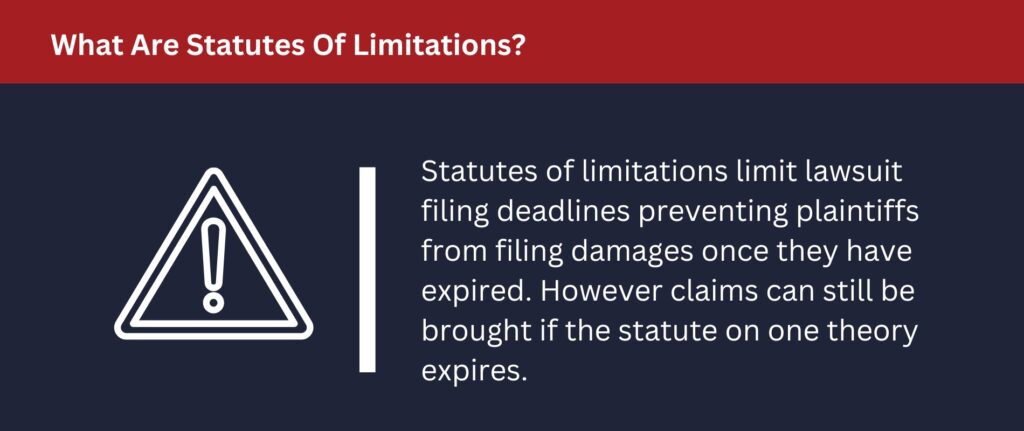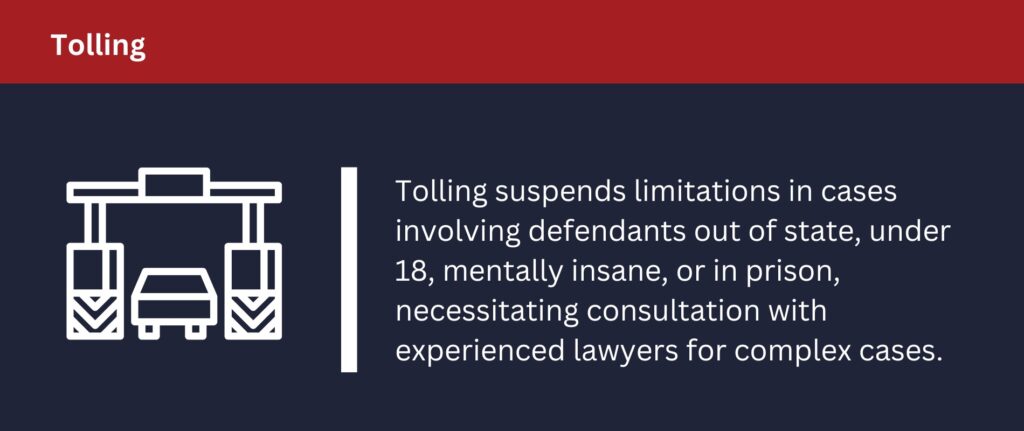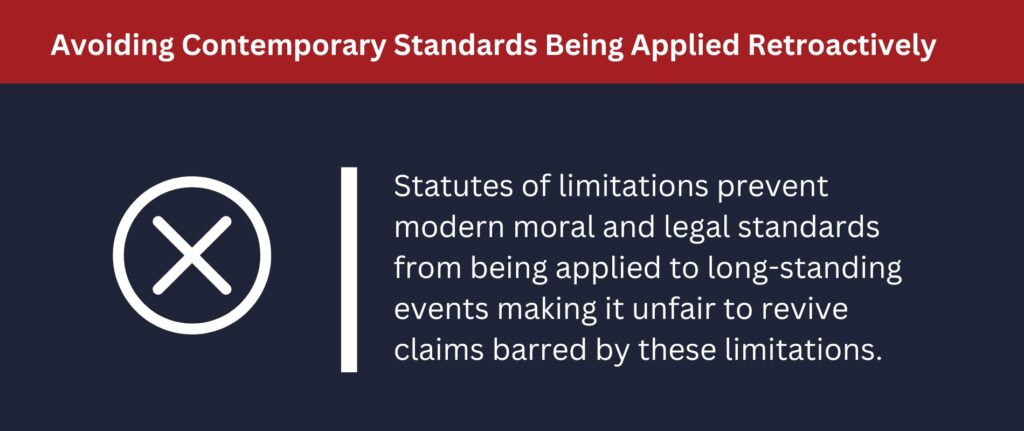
If you’ve been injured in an accident that was at least partially someone else’s fault, there is a time limit for you to file a claim seeking financial compensation for your injuries. In California, that time limit is typically two years from the date you know or should know about the injury.
If you do not bring a claim within this time limit, you are typically barred from bringing the claim in the future.
Common limitation periods in California include:
- Personal injury: 2 years
- Wrongful death: 2 years
- Property damage: 3 years
- Childhood sexual abuse: 5 years after the victim becomes aware of the abuse, or once the victim reaches 40 years old, whichever comes later
- Medical malpractice: 1 year from discovery
- Wrongful birth: 6 years
- Exposure to asbestos: 1 year from discovery
- Claims against government agencies: 6 months
What Are Statutes Of Limitations?

Statutes of limitations are deadlines within which lawsuits need to be filed. Plaintiffs cannot file legal actions for damages once statutes of limitations have expired.
Statutes of limitations depend on what legal theory a lawsuit is based on. Lawsuits often seek to recover damages based on multiple legal theories, so even if the statute on one theory has expired, a claim may still be brought on another theory.
For example, a plaintiff may be injured in an auto accident which was the fault of a defendant. The accident also totals the plaintiff’s car in addition to injuring the plaintiff. The plaintiff attempts to resolve the injury claim with the defendant’s insurance company, who drags out negotiations until the two year statute of limitations expires.
At this point, the plaintiff can no longer file a lawsuit to recover financial compensation for their injuries, but since the statute of limitations for property damage in California is three years, the plaintiff can still file a lawsuit to recover financial compensation for their totaled car. If you are still unsure if you can file a personal injury claim for your accident an experienced attorney can help determine if you are eligible for compensation.
How Long Do I Have To Sue If I’m Injured In California?
You generally have two years from the date of your injury to file a personal injury lawsuit in California. This applies to accidents, assault, wrongful death, battery, negligent infliction of emotional distress, intentional infliction of emotional distress, negligent acts, wrongful acts, etc. However, certain circumstances can cause this time limit to differ:
Tolling

Statutes of limitations are sometimes suspended, or don’t start to run for some time. This is referred to as “tolling.” Examples of situations where statutes of limitations are tolled include when defendants are:
- Out of state
- Under age 18
- Legally insane
- In prison
The time limit starts to run out once the condition that led to tolling ends.
Cases which involve tolling can be very complex, so it’s critical to talk with experienced California personal injury lawyers like Nadrich Accident Injury Lawyers to see if you can still sue over your injuries.
Delayed Discovery
The personal injury statute of limitations in California does not strictly begin running on the date of the injury. Rather, it starts running on the date the injured plaintiff becomes aware of or should become aware of the injury. In other words, the delayed discovery rule delays the beginning of the statute of limitations until the injured party can reasonably discover their injuries.
Delayed discovery applies when:
- A plaintiff doesn’t know about facts that would cause someone reasonable to believe they were harmed and it was someone else’s fault, or
- A good faith investigation and reasonable diligence wouldn’t reveal that a harmful situation or product harmed a plaintiff.
For example, the injuries which result from car accidents can sometimes takes weeks or months to show themselves and cause the injury victim pain. In this case, the statute of limitations starts running from the date the injury victim is diagnosed with an injury by a healthcare provider, not the date of the accident.
Medical Malpractice
Medical malpractice claims must be filed in California within one year that an injury is discovered or should be discovered, or within three years from the date of injury, whichever date comes earlier.
You need to give healthcare providers 90 days’ notice before filing a lawsuit against them in California.
Plaintiffs Who Are Under The Age Of 18
Minors in California do not possess the legal capacity to make decisions. Thus, statutes of limitations are usually tolled for injured minors in California until they turn 18.
However, there are exceptions:
- Claims regarding injuries which occurred before or during birth must be filed within six years of the date of birth
- Minors’ medical malpractice claims need to be filed within three years of the malpractice or, if the child is less than six years old when they are injured, before their eighth birthday, whichever comes later
Crime Victims
Those who are injured in California as a result of crimes don’t necessarily need to sue within a typical two year personal injury statute of limitations.
Those in California who are injured by serious felonies like rape, attempted murder or kidnapping have 10 years from the date a defendant is discharged from parole to file a personal injury lawsuit.
Victims of less serious felonies in California have one year after judgment on a defendant is pronounced to file a lawsuit.
Childhood Sexual Abuse
AB 218 extended the statute of limitations for victims of childhood sexual abuse in California. Child sex abuse victims in California now have until the age of 40, or until five years after they become aware of the abuse, to file a lawsuit, whichever date comes later.
Claims Against Government Agencies

Personal injury and personal property damage claims against government agencies must generally be filed within six months of the date of the injury.
You must file an administrative claim with the government agency before you file a lawsuit in court. You need to use the government form to file the claim.
The government has 45 days to respond after you file a claim. If your claim is denied, you have six months to file in court from the date you received the denial. If your claim is not responded to within 45 days, you have two years from the date the incident happened to file in court.
What Is The Purpose Of A Statute Of Limitations?
Halsbury’s Laws of England, 4th edition, states that there are three reasons for statutes of limitations:
- Valid causes of action should be pursued with reasonable diligence
- Defendants may lose evidence they need to disprove claims by the time stale claims are litigated
- More cruelty may result than justice in litigation of long-dormant claims
Most cases in Classical Athens were subject to five year statutes of limitations. Demosthenes wrote this was in order to control professional accusers.
There are many reasons that statutes of limitations exist:
Promotion Of Repose
It has often been noted that the main reason for statutes of limitation is to promote repose. Repose can mean four separate things in this context:
Allowing peace of mind: Statutes of limitations protect people from unfairly being subjected to the indefinite threat of being sued. Wrongdoers, and those who aren’t certain they have committed a wrong, are thus relieved of the fear they will be sued after a period of time.
Some believe that this approach encourages wrongdoers to reform, letting those who have bettered themselves to have peace of mind that their new, better lives they have worked hard for won’t be ruined by mistakes they made a very long time ago.
Avoidance of disruption of settled expectations: People eventually learn to accept status quo, rely on it, and behave based on it. Someone might obtain something wrongly, but years later they make investments and decisions assuming they will continue to own it.
Statutes of limitations help balance the interests of an injured plaintiff with the injury a defendant would suffer if a claim is allowed to proceed, disrupting the current status quo.
Reduction of uncertainty: Most people are averse to risk. This means that uncertainty costs them opportunities that they could pursue if they had greater certainty.
It may be bad for society to discourage defendants from optimally allocating resources on a long-term basis. The uncertainty of a potential claim looming against someone may prevent them from engaging in business or allocating resources efficiently until the liability risk is resolved.
Reduction of protective measures and associated costs: Risk-averse people faced with uncertainty take measures to protect themselves against negative outcomes. These measures cost money. One common example is the acquisition of insurance coverage. The California Legislature has noted that one goal of enacting statutes of limitation is reducing insurance premiums.
A statute of limitations can reduce uncertainty, allowing people and businesses to reduce taking these expensive uncertainty-related measures, allowing the money to be used in a more socially beneficial way.
Minimization Of Evidence Deterioration
The California Supreme Court has stated:
It is fundamental that the principal purpose of statutes of limitation is to prevent the assertion of stale claims by plaintiffs who have failed to file their action until evidence is no longer fresh and witnesses are no longer available… The statutes, accordingly, serve a distinct public purpose, preventing the assertion of demands which, through the unexcused lapse of time, have been rendered difficult or impossible to defend.
Avoidance of evidence deterioration fulfills several purposes:
It ensures accurate fact-finding: Deterioration or loss of evidence makes it much less likely that claims are resolved accurately and justly. The United States Supreme Court stated:
The process of discovery and trial which results in the finding of ultimate facts for or against the plaintiff by the judge or jury is obviously more reliable if the witness or testimony in question is relatively fresh.
Barring cases from being tried after a limitation period has expired can prevent the effects of evidence deterioration on the legal system’s accuracy.
It prevents fraud: Defendants are more vulnerable to false claims as the gap in time between an event occurring and a lawsuit over that event grows. Statutes of limitations can prevent fraudulent claims from succeeding and prevent fraudulent evidence from being used to support nonfraudulent claims.
Deterioration of evidence can put genuine and fraudulent claims on equal footing. For example, if a plaintiff waits until all five potential witnesses have died, and the witnesses would have favored the defendant, the defendant’s position has clearly been weakened by time.
It reduces litigation costs: It can be more expensive and time-consuming to locate witnesses, assemble documents and reconstruct an event if an event occurred a long time ago. Litigants can respond to evidence deterioration by investing resources to try to remedy this deficiency.
It preserves the legal system’s integrity: If society believes that evidence deteriorates over time and erroneous legal decisions are more likely when the gap in time between an event and litigation over an event is longer, then statutes of limitation enhance the integrity of the legal system in the eyes of society.
Placing Plaintiffs And Defendants On Equal Footing
Without a statute of limitations, a plaintiff can gain an unfair advantage over a defendant by spending years taking steps to preserve evidence that is favorable to their case while evidence favoring the defendant deteriorates. A plaintiff could even intentionally delay filing a lawsuit until the time they believe is the most advantageous for them and the least advantageous for the defendant.
Avoiding Contemporary Standards Being Applied Retroactively

Circumstances change over time, including the law. Conduct encouraged or accepted 20 years ago is no longer tolerated today, and conduct which was not tolerated 20 years ago is encouraged or accepted.
Without statutes of limitations, defendants’ conduct may be measured by standards that are very different from that they could anticipate when they engaged in that conduct. Statutes of limitations thus help prevent modern moral and legal standards from being applied to events that occurred a very long time ago.
California courts have long established that changes in the law do not revive claims that are barred by the expiration of a statute of limitations. This implies that it is unfair to apply new legal standards to events which occurred a long time ago.
Reducing The Number Of Frivolous Lawsuits
Some believe that claims that are delayed for a long time are more likely to lack merit than claims which are filed promptly. This assumes that anyone with a well-founded claim and the ability to sue will file promptly to obtain compensation as quickly as possible.
Do You Need to Speak With A Personal Injury Lawyer
Do you need a lawyer to file a claim? Learn why hiring a skilled personal injury lawyer might be in your best interest by scheduling a free case evaluation today. Discussing the specifics of your case with a legal professional can give you a better picture of the validity of your claim and what your next steps are.

